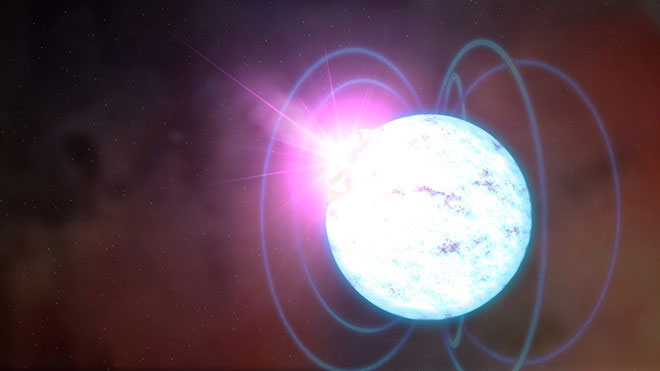Detecting unprecedented neutron stars, challenging the physical limit
Scientists have discovered the largest neutron star ever, with its enormous mass compressed close to the limits set by the laws of physics.
Neutron stars are the smallest stars in the universe, with a diameter probably equal to a city on Earth. It is one of the ending types of a massive star, created after supernova explosions. The star enters an extremely dense state despite its very large mass, many more cases than our Sun.
The newly discovered neutron star is named J0740 + 6620 , about 4,600 light-years from us. It is 333,000 times more massive than Earth and nearly 2.17 times more massive than the Sun. However, all of that huge amount of matter is concentrated in a star with a strike path of just over 24km.
According to CNN, the neutron star J0740 + 6620 has approached the limit of how much an object can compress the total mass before collapsing into a black hole.

Illustrative image of a super magnetic neutron star.(Photo: NASA).
The neutron star is defined as a pulsar, which rotates rapidly and generates radio waves from both poles. The pulsar acts as an atomic clock of the universe because the wavelength it produces is cyclical. Astronomers can rely on this object to study the universe and time.
The neutron star J0740 + 6620 was discovered by the Green Bank telescope in West Virginia. The scientists just published their findings in the journal Nature Astronomy on September 16. They initially did not purposely search for "record" neutron stars, but were studying gravitational waves.
"We want to detect gravitational waves of pulses with the Green Bank telescope. To do that, we need to observe pulses rotating at milliseconds. This is not a research paper on gravitational waves that are just one of many important results we have achieved after our observations, " said Maura McLaughlin, professor of physics and astronomy at West Virginia University.
Scientists still have many unanswered questions about neutron stars. Astronomers want to know if a neutron star reaches its "superfluid" state , how that process will take place and where gravity begins to act.
The unique finding of McLaughlin and his colleagues can help shed some light on the mysteries of the universe.
- What is a Neutron Star?
- Roscosmos announces the sound of neutron stars
- Gravitational waves bring people to an unprecedented phenomenon in astronomical history
- The original gold smelter in the universe
- Finding strange stars Neutron is twice as massive as the Sun.
- Discover the source of gravitational waves from neutron stars
- New discovery: Collisions of neutron stars produce heavy elements of strontium
- Detecting new types of metabolism of neutron particles
- The gravitational wave suspected by the black hole swallowed the neutron star emitted
- Video: The crazy dance of Vela neutron stars
- The thousand-star explosion shot gold, silver and platinum throughout the universe
- Eistein is right, neutron stars make space-time twists
 Van Allen's belt and evidence that the Apollo 11 mission to the Moon was myth
Van Allen's belt and evidence that the Apollo 11 mission to the Moon was myth The levels of civilization in the universe (Kardashev scale)
The levels of civilization in the universe (Kardashev scale) Today Mars, the sun and the Earth are aligned
Today Mars, the sun and the Earth are aligned The Amazon owner announced a secret plan to build a space base for thousands of people
The Amazon owner announced a secret plan to build a space base for thousands of people